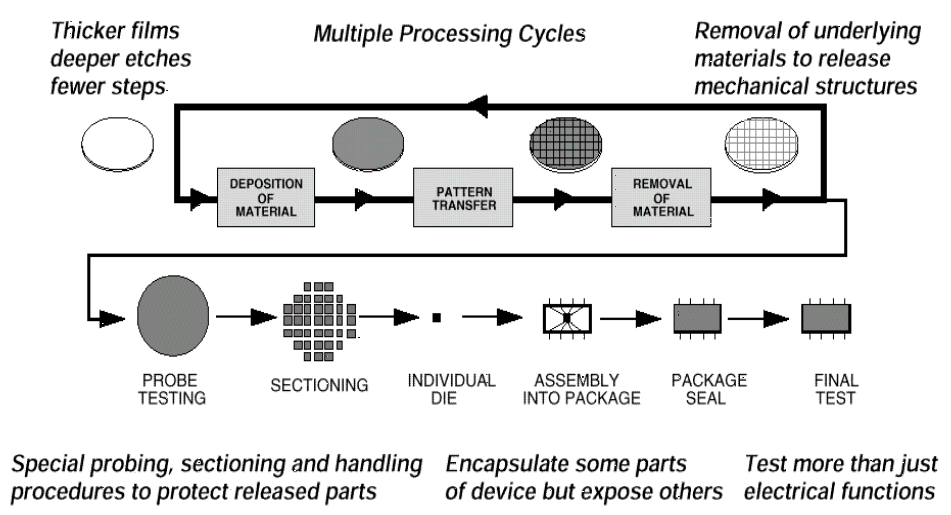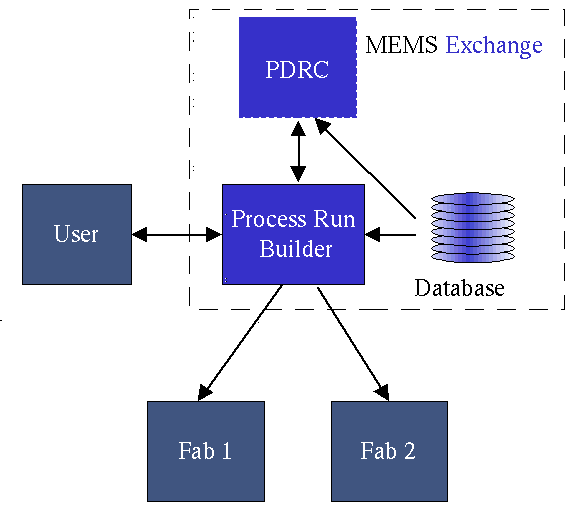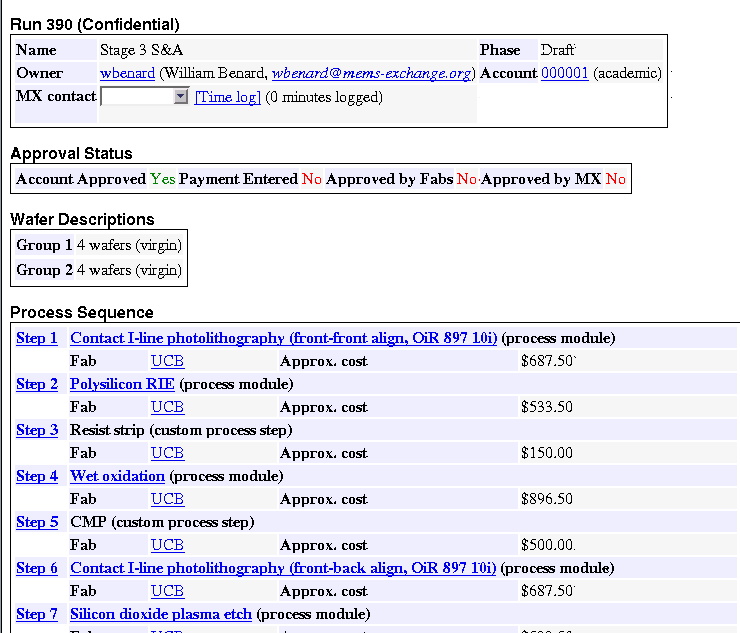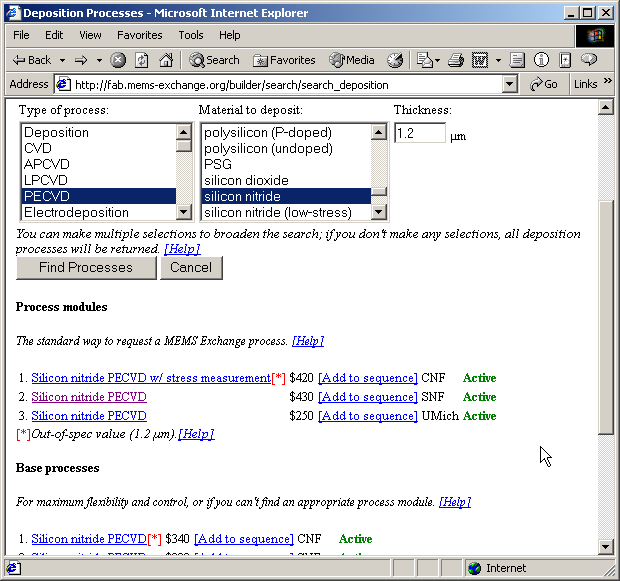The MEMS Exchange Application Architecture
DC Zope/Python User Group
January 16, 2002
A.M. Kuchling
www.amk.ca
amk @ amk.ca
Topics
- Introduction to MEMS
- Introduction to the MEMS Exchange
- ZODB
- Unit testing
- Quixote
What are MEMS?
MEMS = MicroElectroMechanical Systems
They combine perception, computation, and actuation.
- Sensors perceive environment
- Electronics process sensory information and make decisions
- Actuators control the environment
 |
 |
 |
 |
Diversity of MEMS Applications
| Inertial Measurement | Accelerometers, gyroscopes, vibration sensors |
| Microfluidics | Gene chips, lab on a chip, chemical sensors, flow controllers, microvalves, micronozzles |
| Optical MEMS | Optical switches, displays, adative optics |
| Pressure Measurement | Auto sensors, medical sensors, industrial sensors |
| RF Technology | RF switches, filters, variable capacitors, inductors, antennas, phase shifters, scanned aperatures |
| Other | Data storage, picosatellites, actuators, etc. |
MEMS Builds on Microelectronics Manufacturing

MEMS Processing
- MEMS usually starts with a silicon wafer (but not always)
- MEMS processes combine IC processes with highly specialized micromachining processes
| IC
Processes Oxidation Diffusion LPCVD Photolithography Epitaxy Sputtering Ion Implantation Etc. |
Micromachining
Processes Bulk Micromachining Surface Micromachining Wafer Bonding LIGA Deep Silicon Reactive Ion Etching Micromolding Etc. |
Some facts about MEMS
- IC process sequences are for the most part standardized,
fixed (CMOS, Bipolar, BiCMOS)
- The materials and their thicknesses are fixed
- The ordering of the processing steps are also fixed
- MEMS process sequences are usually very customized -- both in materials used and in the ordering of the processing steps
- Some micromachining processes are incompatible with IC processes
- MEMS product development usually requires an R&D effort dedicated to development of a viable process sequence
Some facts about MEMS (cont'd)
- Separation between design and fabrication in IC technology is clear
- MEMS design and fabrication are intertwined
- IC manufacturing is large volume production
- Many MEMS applications require small volume
- MEMS fabrication sites are scattered around the country, and vary in their skills
- Access to MEMS prototyping and manufacturing is limited
What is the MEMS Exchange?
The MEMS Exchange will perform a process sequence in order to create a device. The process sequence can be spread across several individual fabrication facilities for the sake of process and design freedom.
The MEMS Exchange virtual fabrication network allows flexibility in:
- discrete processing steps
- ordering of processing steps
- materials
- processing site(s)
- volume and cost
- response time
Current Fabs
Academic
- U. of California at Berkeley
- Case Western Reserve University
- Cornell
- U. of Illinois at Chicago
- Louisiana State
- U. of Michigan
- Stanford
Commercial:
- ASML
- AXSUN Technologies
- Aspen Technologies
- ...
Using the MEMS Exchange

- Through Web, browse for processes & develop a customized process sequence
- User submits sequence to us as a "work request"
- We review request, & forward it to fab sites for approval
- User submits sequence as a "work order"
- Fabrication begins
Process Catalog

A Process Run

Run Builder

MX User's Personal Page

Process Rule Checker

Entering Metrology

First step toward building Web-based tools.
Checks a sequence for violations of several different rules.
Also graphically displays the layers being built up.
ZODB Primary Objects
ProcessLibrary <<database root
BaseProcess
Parameter
PhysicalValue
ProcessModule
...
UserDatabase <<database root
User
Group
RunDatabase <<database root
ProcessRun
ProcessSequence
[ProcessStep1, ...]
Parameter
TemplateLibrary, BusinessDatabase, MaterialDatabase, ...
Why Not Use an RDBMS?
- Too slow (all those joins!)
- Ugly programming interface
- SQL knowledge creeps throughout the code
- Difficult to change schema
- Classical SQL queries not very useful to us
Instead, we use the ZODB. Our database has:
- 659 ProcessRuns
- 3866 ProcessSteps
- 4325 Parameters,
- 306000 objects total, taking up around 100 Mb of disk space.
ZODB Overview
- An object persistence system for Python
- Part of Zope's infrastructure
- I've packaged it for standalone release; a Zope Corp. release is imminent.
Features:
- Supports transactions
- Not fully ACID, though (no Consistency)
- Supports different physical storages
Note: ACID = Atomicity, Consistency, Isolation, Durability
ZODB: Example
from ZODB import DB
from ZODB.FileStorage import FileStorage
storage = FileStorage('/tmp/test-filestorage.fs')
db = DB(storage)
conn = db.open()
root = db.root()
user_db = root['user_db']
newuser = User('amk')
userdb.users['amk'] = newuser
get_transaction().commit()
Replace FileStorage with
BerkeleyStorage to use a different low-level storage
mechanism.
ZEO consists of a ClientStorage class which
retrieves objects over a socket, and a server that the
ClientStorage can talk to.
Making a Class Persistent
- Subclass Persistence.Persistent
That's it! There are a few rules to keep in mind, though...
import ZODB
from Persistence import Persistent
class User(Persistent):
def __init__ (self):
self.email = None
self.names = []
def add_name (self, name):
self.names.append(name)
self._p_changed = 1
Rules for Persistent Classes
- When modifying mutable objects, set dirty bit
(
_p_changed) isinstance(),issubclass()don't work.- Some special methods don't work either;
__cmp__,__r*__, ...) __setattr__,__delattr__must set dirty bit manually
An updated version for Python 2.2 should make #2 and #3 go away (eventually).
MX Database Structure
BusinessDatabase UserDatabase RunDatabase ResultsDatabase
BTree: abenard akuchlin gward mhuff nascheme
<User at 0000000000000ef3: akuchlin>
prefix/first/last/suffix: Mr/Andrew/Kuchling/
email: 'amk@amk.ca'
address: <Address at 0000000000000f2d>
...
_p_changed: false
<Address at 0000000000000f2d>
street1/2/3: 1320 N. Veitch St., #608//
city/state/zip: Arlington/VA/22201
...
_p_changed: false
Issues
- Packing the DB (no use for versions)
- Ad hoc changes (this won't take a minute...)
- Typos (self.templtae instead of .template)
- Type correctness (this attribute should be a string)
- Correctness (ensuring singletons remain singletons)
Solutions
- expire_sessions (packs the database and does cleanup)
- opendb (use the Python interpreter to access our database)
- Grouch (a type-checking tool)
- zodb_census (counts the population of different objects)
- zodb_index (following and finding references)
expire_sessions
- A script run nightly from cron
- Expires old sessions that haven't been accessed
- Copies the mxdb.fs to mxdb.fs.YYYYMMDD
- Packs the mxdb.fs
opendb
Provides a comfy interactive prompt.- Variables for the root objects
- Shortcuts for common tasks
- History using PyRepl
opendb transcript
ludwig akuchlin>opendb
root databases available:
template_lib
process_lib
run_db
user_db
business_db
results_db
session_manager
shared_cache
other variables and functions:
database
connection
root
commit() = get_transaction().commit()
abort() = get_transaction().abort()
sync() = connection.sync()
>>> r = run_db.get_run(113)
>>> r.owner
<User at 839e2f8: akuchlin>
>>> r.owner = user_db.get_user('gward')
>>> r.owner
<User at 83a0348: gward>
>>> commit() # commit the transaction
Grouch: introduction
Grouch is an after-the-fact type-checker that we run nightly.- Class docstrings describe types of each attribute.
- Notifies us of:
- incorrect types
- missing or extra attributes
- Does not detect bugs immediately.
Grouch: Docstring format
class ProcessRun(MXPersistent):
"""
Instance attributes:
run_id : int
the unique identifier for this process run
name : string
the user-supplied name of this run
owner : User # notnone
the individual user who owns this run
billed : DateTime | boolean
whether or not we've sent a bill to the customer for this run
review_comments : PersistentList [Comment]
An always-growing list of comments...
"""
Grouch: Output of a checking run
Type-checking discovered database errors; here they are:
run_db.runs[639].object_versions[6].sequence._key_map['S0002'].wafer_ids['W001']
.description.resistivity.unit.dims:
expected attribute 'dimension_names' not found
run_db.runs[639].object_versions[6].sequence._key_map['S0002'].wafer_ids['W001']
.description.resistivity.unit.dims:
expected attribute 'num_dimensions' not found
run_db.runs[639].object_versions[6].sequence._key_map['S0002'].wafer_ids['W001']
.description.resistivity.unit.dims:
expected attribute 'dimension_powers' not found
make: *** [check] Error 1
zodb_census
Loops through the OIDs in the database, and counts up the number of instances for each class.ute tools>MX_DB=file:/www/var/mxdb.fs python zodb_census.py opening database... expecting to see 306153 objects maximum expected OID: 00000000000abe43 OID: 00000000000abe44 (objects seen: 306153) census completed total OIDs attempted: 704068 empty slots seen: 397915 actual objects seen: 306153 objects seen by type: ActiveVersionCollection 963 Address 1861 AlignmentMark 51 BaseProcess 2324 BusinessDatabase 1 ... OOBTree 15 OOBucket 296 Parameter 29585 ParameterList 17966 ProcessHierarchy 1 ProcessLibrary 1 ProcessModule 840 ProcessRun 1885 ProcessSequence 1885 ProcessStep 16990 RunDatabase 1 ...
zodb_index: Explanation
Builds an index of the references in the ZODB's object graph, and lets you explore it.
- -c: builds a fast index of the references in a ZODB.
- Time-consuming to build index (10-15 minutes for our DB)
- -f: report all OIDs referenced by an object
- -r: report all OIDs that refer to an object
- -C: report all instances of a given class
Debugging with zodb_index (I)
(Finding a bug, as demonstrated by Greg Ward on our internal mailing list)
First, a mystery:
$ opendb [...] >>> len(user_db.users) 775 $ make census [...] User 873
There are almost 100 more User objects in the ZODB than users
in our UserDatabase object.
Debugging with zodb_index (II)
Let's list those 874 objects, sorted by user ID:
$ ./tools/zodb_index.py -C mems.access.user.User | sort -f -b +4 [...] 00000000000380d0: <User at 83805c8: akuchlin> 00000000000010ca: <User at 83278d8: gward> 0000000000000011: <User at 816cd18: Hexon> 000000000001a5d1: <User at 8332608: Hexon> 000000000001e4b1: <User at 833a138: Hexon> 0000000000021943: <User at 83437c0: Hexon> 0000000000023c4c: <User at 8346be8: Hexon> 00000000000317af: <User at 82c0578: Hexon> 00000000000010c9: <User at 83258d0: wbenard>
6 objects for the user "Hexon"?!?
Debugging with zodb_index (III)
Running zodb_index.py -r 0000000000000011 shows
251 refs to OID 11, so we'll guess that OID 11 is The One True
User Object for Hexon, and the others are impostors.
Let's dig deeper...
$ ./tools/zodb_index.py -r 1a5d1 1e4b1 21943 23c4c 317af
000000000001a5d1: <User at 81e4768: Hexon>
000000000001a5d0: <Review at 8220698>
000000000001a5d2: <FabProvider at 82248d0: UMich>
000000000001a5d2: <FabProvider at 82248d0: UMich>
000000000001a608: <Comment at 8231b88: Hexon at 2001-04-27 14:34:31.51>
0000000000060994: <Review at 8230a28>
0000000000060b00: <Comment at 822ff60: Hexon at 2001-04-27 14:34:31.51>
000000000001e4b1: <User at 8224550: Hexon>
000000000001e4b0: <Review at 8232308>
000000000001e4b2: <FabProvider at 822ff00: UMich>
000000000001e4b2: <FabProvider at 822ff00: UMich>
000000000001e5e7: <Comment at 8233138: Hexon at 2001-04-25 15:58:12.17>
0000000000021943: <User at 81e3a38: Hexon>
0000000000021942: <Review at 8232ca0>
...
ZODB Enhancements We'd Like to See
- Standalone releases from Zope Corp.
- Use Python 2.2 features instead of ExtensionClass
- Follow Unix daemon conventions
- Concurrent access without ZEO?
- Getting too big to iterate over the whole database?
- Incorporate
zodb_index-style reference indexing? - Maybe incorporate some of our tools (opendb, MXBase?)
Unit Testing
We have over 4000 tests for our basic objects. The existence of this test suite gives us confidence when we refactor the code.
Consider this simple function:
def f(s, val):
if val < 0:
raise ValueError, 'val cannot be negative'
elif val == 42:
print 'The answer!'
return s * val
Unit Testing Example
from quixote.test.unittest import TestScenario, parse_args, run_scenarios
import module
tested_modules = ['module']
class MyFunctionTest (TestScenario):
def setup(self): pass
def shutdown(self): pass
def check_func(self):
"Test the function's output: 6"
# Test the null case (val == 0)
self.test_val( "module.f('', 0)", '')
self.test_val( "module.f('abc', 0)", '')
# Test the identity (val == 1)
self.test_val( "module.f('', 1)", '')
self.test_val( "module.f('abc', 1)", 'abc')
# Test a real case (val == 3)
self.test_val( "module.f('', 3)", '')
self.test_val( "module.f('abc', 3)", 'abcabcabc')
if __name__ == "__main__":
(scenarios, options) = parse_args()
run_scenarios (scenarios, options)
Example output
When run, this test case prints:
ute /tmp>python test.py
FunctionTest:
ok: Test the function's output ('func') (6 tests passed)
passed) ok: 9 tests passed
ute /tmp>
Or, in case of failure:
ute /tmp>python test.py
MyFunctionTest:
not ok: Test the function's output ('func') (6 tests expected, 6 run, 2 failed)
not ok: module.f('', 0) != '' (raised ValueError: "val cannot be negative")
failed at test.py, line 12 (in 'check_func()'):
self.test_val( "module.f('', 0)", '')
File "/home/amk/src/mems/quixote/test/unittest.py", line 337, in test_val
val = eval (code, globals, locals)
File "<string>", line 0, in ?
File "module.py", line 3, in f
raise ValueError, 'val cannot be negative'
not ok: module.f('abc', 0) != '' (raised ValueError: "val cannot be negative")
...
not ok: 6 tests expected, 6 run, 2 failed
ute /tmp>
Code Coverage
ute /tmp>python test.py -c
MyFunctionTest:
ok: Test the function's output ('func') (6 tests passed)
passed) ok: 6 tests passed
code coverage:
module: 83.3% (5/6)
ute /tmp>python test.py -c -v
... additional output while running the tests deleted ...
ok: 6 tests passed
code coverage:
module:
.
10: def f(s, val):
9: if val < 0:
1: raise ValueError, 'val cannot be negative'
8: elif val == 42:
>>>>>> print 'The answer!'
.
8: return s * val
83.3% (5/6)
kronos /tmp>
Testing a tree of modules
ute proto3>~/src/mems/tools/run_tests.py -r . looking for test scripts...found 45 ok: lib/test/test_pvalue.py: 118 tests passed ok: lib/test/test_range.py: 129 tests passed ok: lib/test/test_unit.py: 109 tests passed ... ok: template/test/test_eqtemplate.py: 14 tests passed ok: prc/test/test_inter.py: 0 tests passed ok: 4000 tests passed
Code coverage: grouch.valuetype: 36.6% (168/459) mems.run.process_run: 43.1% (202/469) mems.tools.unittest: 45.4% (237/522) mems.lib.base: 46.9% (75/160) grouch.util: 48.1% (26/54) mems.process.process_module: 52.4% (100/191) ...
Quixote
Quixote is our environment for building Web applications.
Design goals:
- To make the environment as similar to regular Python as possible.
- To focus on Web applications that are heavy on programming, light on graphic design.
- To avoid magic.
Features:
- Supports regular CGI, FastCGI, and our own mod_scgi.
- Uses Python Template Language for generating HTML.
- Includes components for form processing, session tracking, unit testing.
Structure of a Quixote Application
An app is a Python package whose name is specified in a
config. file. (mems.ui,
quixote.demo)
webapp/
__init__.py
module1.py
module2.py
pages1.ptl
pages2.ptl
A URL is mapped to a callable Python object by traversing objects starting from the base package.
| http://www/ | calls | webapp._q_index |
| http://www/simple | calls | webapp.simple |
| http://www/run/ | calls | webapp.run._q_index |
Example Code
__init__.py:
_q_exports = ["simple", "error", "widgets"]
import sys
from quixote.demo.pages import _q_index
from quixote.demo.widgets import widgets
from quixote.demo.integer_ui import IntegerUI
def simple (request):
# This function returns a plain text document, not HTML.
request.response.set_content_type("text/plain")
return "This is the Python function 'quixote.demo.simple'.\n"
request wraps up:
- form input
- environment variables,
- the response's content type and headers.
HTML Templating
Most templating syntaxes look like HTML with a bit of additional syntax.
| PHP |
<? for ($i=1; $i<10; $i++) print $i;> |
| ASP |
<% addr = Request.form("email"); %>
|
| DTML | <dtml-var "row"> or <!--#var "row"--> |
Our syntax looks completely different, though still familiar...
Python Template Language
pages.ptl:
template _q_index(request):
print "debug message from the index page"
"""
<html>
<head><title>Quixote Demo</title></head>
<body>
<h1>Hello, world!</h1>
"""
"<table>"
for i in range(10):
make_row(i)
"</table>"
template make_row(num):
"<tr><td colspan=%i>%i</td></tr>" % (num, num)
How PTL Works
When Python evaluates a lone expression, it discards the result:
def f():
string.lower('abc')
return 1
In PTL, the result is converted to a string and appended to the output.
template numbers(n):
for i in range(n):
i
" " # add whitespace
An import hook lets us import PTL files as if they're regular Python modules:
from quixote import enable_ptl enable_ptl() from webapp.pages import simple
Why We Like PTL
- Flexibility: need to import an arbitrary Python module? Want to write a little helper function? Go ahead...
- Readability.
- Indentation makes the structure clear.
- The escape sequence is short, which matters in the face of standard programming practice (factoring out common code).
- We already have
viand Emacs modes for it.
Quixote's Special Methods
_q_index (request) : string
When traversal stops at a module or package, this is the default
function name that's tried.
_q_access (request)
When found along the way, this function is called and must not
raise an exception to let traversal continue.
_q_getname (request, component) : object
When a name isn't found, _q_getname will be called.
If it returns an object, traversal will continue with this
object.
_q_access(request)
Access control function; traversal can go no further if it raises an exception.
def _q_access (request):
from mems.ui.lib.errors import NotLoggedInError
if request.session.user is None:
raise NotLoggedInError, ("You must be signed in to view runcards.")
This saves us from having to write checking code for every public function. Instead, we can just put an access restriction on the whole module.
_q_getname(request, component)
"/run/200/" is a more readable URL than "/run/?run_id=200".
_q_getname gets called with the current request
and the component of the URL path. If it returns an object,
traversal continues with that object.
mems/ui/run/__init__.py
def _q_getname (request, component):
return RunUI(request, component)
class RunUI:
_q_exports = ['details', 'check', ...]
def __init__ (self, request, component):
run_db = get_run_database()
self.run = run_db.get_run(int(component))
template _q_index (self, request):
# /run/200/
... return index page ...
template details (self, request):
# /run/200/details/
... return a more detailed page ...
Form Framework
An optional part of Quixote that lives in the
quixote.form subpackage, the framework lets us
quickly implement basic (and not so basic) HTML forms.
Features:
- Contains many different widgets (StringWidget, PasswordWidget, CheckboxWidget, etc.)
- It's also possible to write custom widgets (PhysicalValueWidget, MaterialWidget)
- Can use hidden form tokens to prevent cross-site request forgery attacks.
The Form Class
Is a container for child widgets, and has three methods:
- render(): returns HTML for a Web page containing the form.
- process(): parses and checks user-supplied input values, flagging any errors.
- action(): finishes whatever action the form does (creating a new object, updating a database, whatever)
Widgets then produce HTML, and handle parsing of the resulting form element.
Example Form Code (I)
class LoginForm (Form):
def __init__ (self, request):
Form.__init__(self)
self.add_widget(
"string", "user_id",
value=self.default_user_id,
title="User ID",
size=15, maxlength=32)
self.add_widget(
"password", "password",
title="Password",
size=15, maxlength=32)
self.add_submit_button(name='login', value="Sign In")
template render (self, request, action_url):
title = "Sign In to the MEMS Exchange"
standard.header(request, title, tree_info=[])
for widget in self.widget_order:
widget.render(request)
"<br>"
for button in self.submit_buttons:
button.render(request)
standard.footer(title)
Example Form Code (II)
def process (self, request):
form_data = Form.process(self, request)
user_id = form_data["user_id"]
password = form_data["password"]
if user ID check fails:
self.error['user_id'] = "Invalid user ID"
elif not valid_password(user, password):
self.error['password'] = "Invalid password"
self.user = user
return form_data
def action (self, request, submit, form_data):
request.session.set_user(self.user)
self.user.record_login(request.get_environ("REMOTE_ADDR"))
Availability
These slides:
http://www.amk.ca/talks/
More on the MX toolset:
http://www.amk.ca/python/writing/mx-architecture/
ZODB/ZEO package:
http://www.amk.ca/zodb/
Grouch:
http://www.mems-exchange.org/software/grouch/
Quixote:
http://www.mems-exchange.org/software/quixote/
Join the quixote-users mailing list.